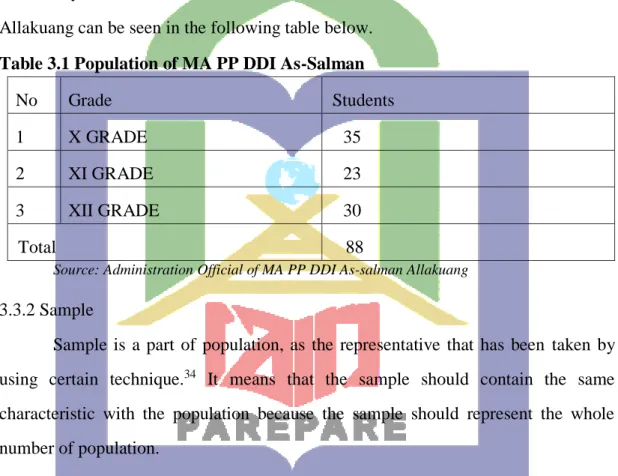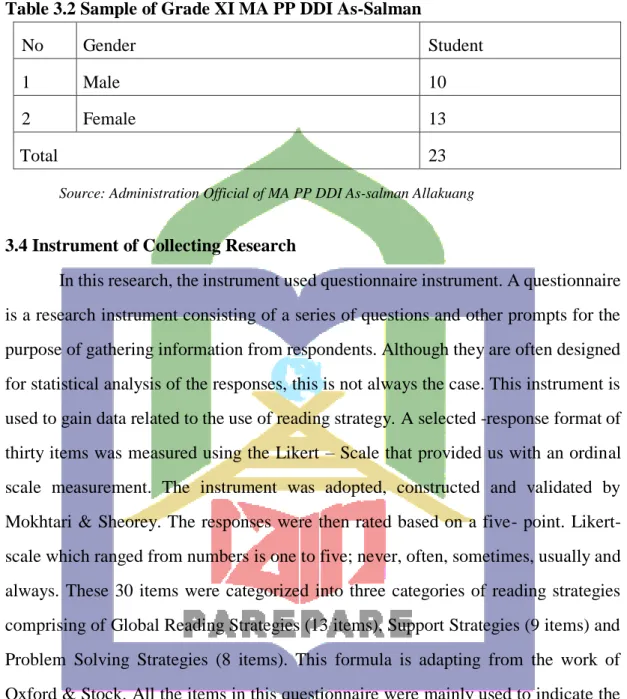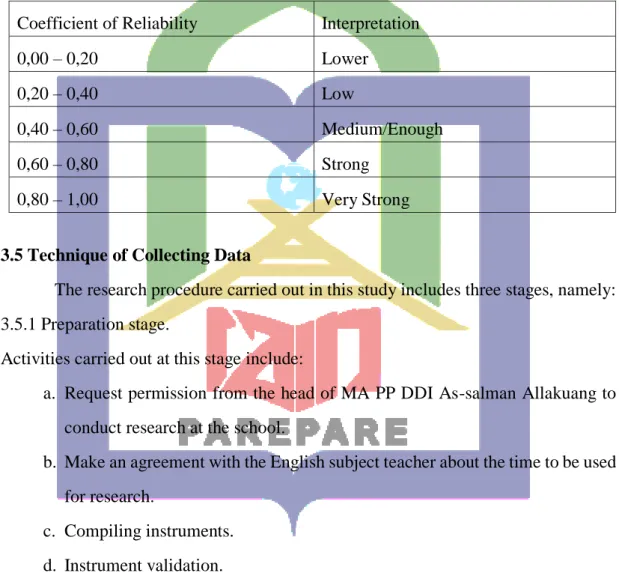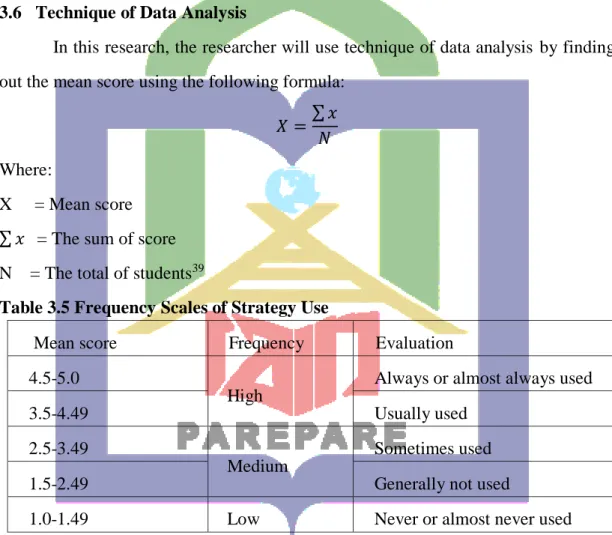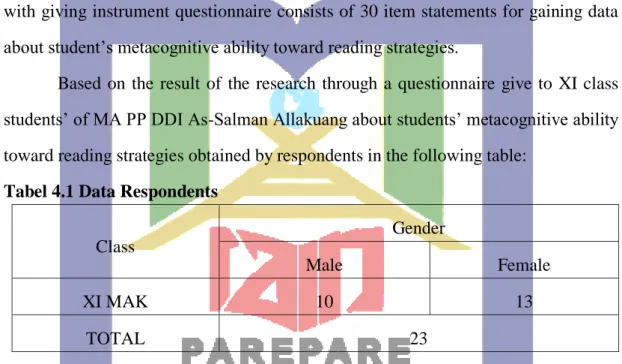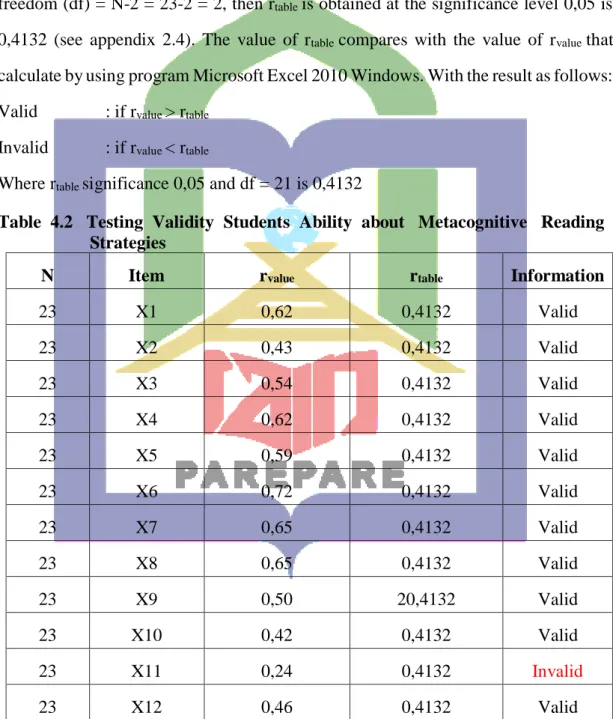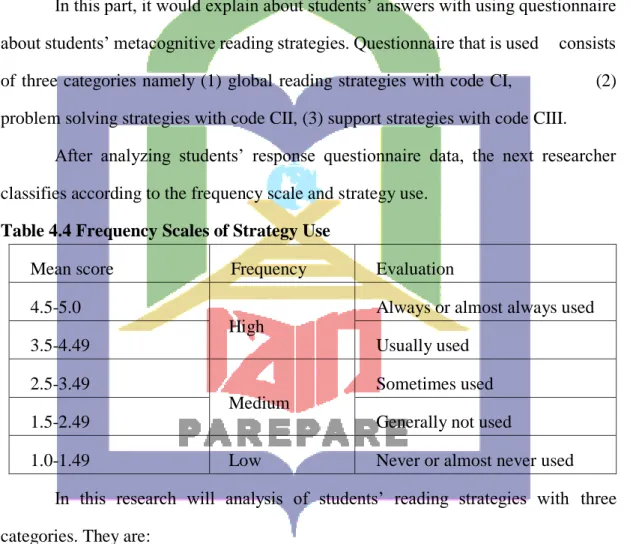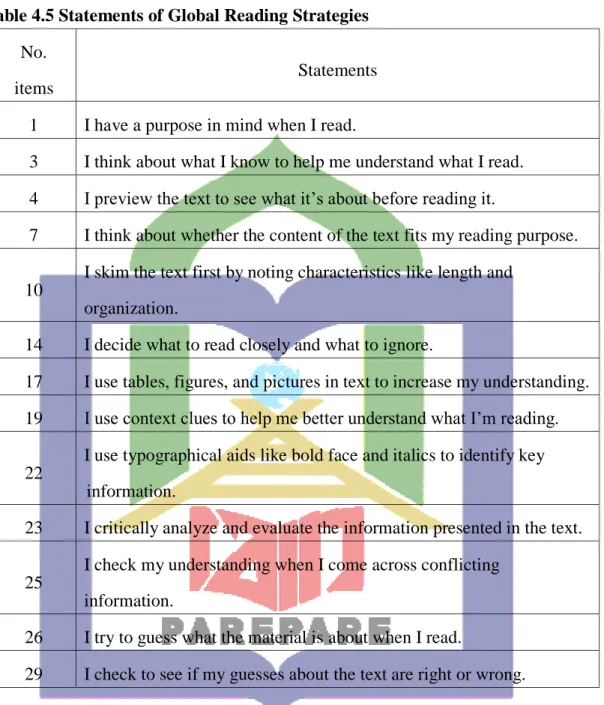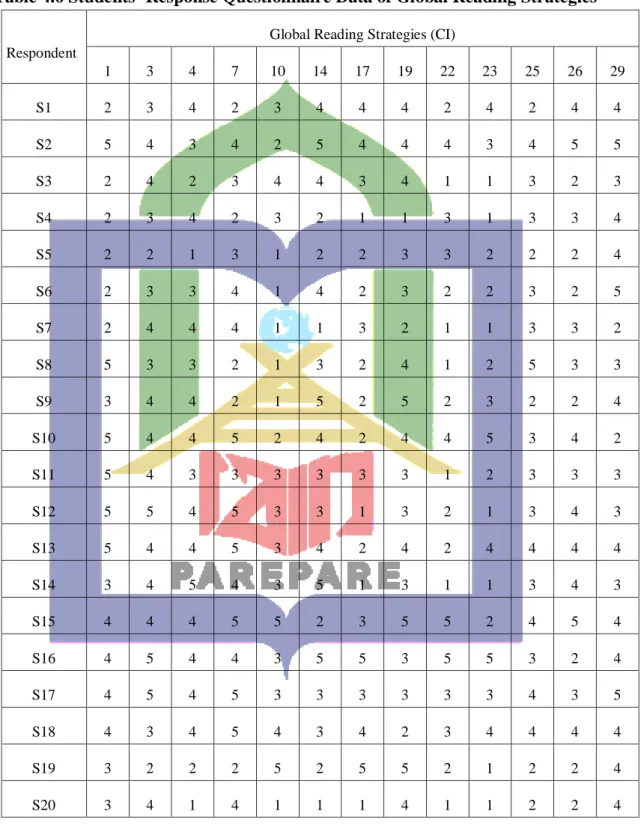i
GRADE OF MA PP DDI AS-SALMAN ALLAKUANG SIDRAP
By
HIKMAH
Reg. Num: 14.1300.106
ENGLISH PROGRAM TARBIYAH FACULTY
STATE ISLAMIC INSTITUTE (IAIN) PAREPARE
2019
ii
GRADE OF MA PP DDI AS-SALMAN ALLAKUANG SIDRAP
By
HIKMAH
Reg. Num: 14.1300.106
Submitted to the English Program of Tarbiyah Faculty of State Islamic Institute of Parepare in Partial of Fulfilment of the Requirements for the Degree of
Sarjana Pendidikan (S.Pd)
ENGLISH PROGRAM TARBIYAH FACULTY
STATE ISLAMIC INSTITUTE (IAIN) PAREPARE
2019
iii
SKRIPSI
As Partial Fulfillment of the Requirements for the Degree of Sarjana Pendidikan (S.Pd)
English Program
Submitted by
HIKMAH
Reg Num. 14.1300.106
to
ENGLISH PROGRAM TARBIYAH FACULTY
STATE ISLAMIC INSTITUTE (IAIN) PAREPARE
2019
vii
Alhamdulillahi Rabbil ‘Alamin, Praise and deep gratitude to Allah SWT for abundance of grace and guidance of him given to the writer that finished this skripsi entitled: The Analysis of the Student’s Metacognitive Ability on Reading Strategies at the Eleventh Grade of MA PP DDI As-Salman Allakuang Sidrap. Shalawat and Salam are hopefully given to the prophet Muhammad SAW (peace be upon him) that had been in communicating the message and the Shari’a of Islam to all mankind.
The writer would like to say thank profusely for all the help that has been given, either directly or indirectly during the preparation of this skripsi to be completed. First of all, the writer wants to say her greatest gratitude to writer’s beloved parents,Bakri and Kaimah who always give pray, love, spirit, and patience so the writer gets facility in finishing this skripsi. Then, the writer would like to say thanks to her consultants Hj. Nurhamdah, S.Ag., M.Pd. and Dr. Abdul Haris Sunubi, S,S., M.Pd. as the first and the second consultant for their guidance, suggestion, patience, and time in helping her to complete this skripsi. In particular gratitudes that are due to:
1. Dr. Ahmad Sultra Rustam, M. Si. as the rector of IAIN Parepare who has worked hard to manage education at IAIN Parepare.
2. Dr. H. Saepudin, S.Ag., M.Pd. as the chairman of Tarbiyah faculty of IAIN Parepare, who has arranged a positive education for the students in the faculty of tarbiyah.
3. Mujahidah, M.Pd as the Chairman of English Study Program at IAIN Parepare, who always give contribution for English program to be better.
viii
5. Head of IAIN Parepare Library and all his staff who has provided good service to the writer since study at IAIN Parepare and in collecting references.
6. Dr. KM Abdul Malik Tibe, S.HI., M.A. as the Head Master of MA PP DDI As- Salman Allakuang who has allowed and helped to conduct this research. Thanks for your support and contribution.
7. Huriati, S.Pd. as English teacher and all the teachers at MA PP DDI As-Salman Allakuang. Thank you for your help and support to the writer during the research and all the students at MA PP DDI As-Salman, especially in class XI the class where the writer did the research. You are so amazing.
8. The great thanks dedicated to beloved brothers and sisters. They have cared for the writer, always give their pray, support, and spirit so the writer can do many things until today. Especially thank to Hasnah Bakri for helping the writer when the writer got problem, always gave advices to the writer and help the writer to finish this skripsi.
9. All beloved friends in Mardatillah who always support the writer in all condition.
Especially The writer’s Mardatillah friends in STAIN Parepare. They are Nur Aprianti, Ayu pratiwi, Nurul khaerunnisa, Ulwiah Majid and Henrika safitri who always support the writer, share knowledge and always give advices to the writer.
10. The big family of English Department/PBI TUA (2014) and all members of MASSIDDI (Mahasiswa Islam Sidenreng Rappang Indonesia). Thanks for becoming the second home. Place that used to sharing, playing, and learning by the writer. It will become unforgettable moment.
ix
things that are useful and add insight to the reader sand especially for the writer as well.
Parepare, February 14th 2019 The Researcher
HIKMAH
Reg Num. 14.1300.106
DECLARATION OF THE AUTHENTICITY OF THE SKRIPSI
The researcher who signed the declaration below:
Name : HIKMAH
x
Title of Skripsi : The Analysis of Students’ Metacognitive Ability on Reading Strategies at the Eleventh Grade of MA PP DDI As-Salman Allakuang Sidrap
State that this skripsi is her own writing and if can be proved that it was copied, duplicated or complied by any other people, this skripsi and the degree that has been gotten would be postponed.
Parepare, February 14th 2019 The Researcher
HIKMAH
Reg Num. 14.1300.106
ABSTACT
xi
strategies. This research aims to find out the ability of the students’ metacognitve reading strategies. The writer applied a descriptive design to answer the problem of this study.
The subject of this research was the eleventh grade students of MA PP DDI As-salman Allakuang Sidrap. The writer applied stratified random sampling technique and took class XI that consists of 23 students as a sample of the research. The writer used questionnaire consists of 30 statements as a instrument of the research which classified in three classifications were high, medium and low.
The result of this research indicated that the students’ ability of metacognitive reading strategies were medium. It presents descriptive statistics for overall frequency of each of the three categories of strategies in reading. The results show that as far as the three categories of strategies were concerned, the students showed a medium strategy use, with problem solving strategies (Mean = 3,364) as their prime choice, followed by support strategies (Mean = 3,217) and global strategies (Mean = 3,094).
Keywords : Metacognition, Metacognitive Reading Strategies
TABLE OF CONTENTS
xii
ACKNOWLEDGEMENTS ... iv
DECLARATION OF THE AUTHENTICITY OF THE SKRIPSI ... vii
ABSTRACT ... viii
TABLE OF CONTENTS ... ix
LIST OF TABLES ... xi
LIST OF FIGURES... xii
LIST OF CHART ... xiii
LIST OF APPENDIX ... xiv
CHAPTER I. INTRODUCTION ... 1
1.1 Background ... 1
1.2 Problem Statement ... 3
1.3 Objective of the Research ... 3
1.4 Significance of the Research ... 4
CHAPTER II. REVIEW OF RELATED LITERATURE ... 5
2.1 Previous Related Research ... 5
2.2 Some Pertinent Ideas... 7
2.2.1 Reading ... 7
2.2.2 Reading Comprehension ... 9
2.2.3 Reading Strategies ... 10
2.2.4 The Important of Reading Strategies ... 11
2.2.5 Definition of Metacognition ... 12
xiii
2.3 Research Variable ... 17
2.4 Conceptual Framework ... 18
CHAPTER III. RESEARCH METHOD... 19
3.1 Design of Research ... 19
3.2 Location and Duration of the Research ... 19
3.3 Population and Sample ... 20
3.3.1 Population ... 20
3.3.2 Sample... 20
3.4 Instrument of Collecting Research... 21
3.5 Technique of Collecting Data………. 25
3.6 Technique of Data Analysis ... 26
CHAPTER IV. FINDING AND DISCUSSION ... 27
4.1 Findings ... 27
4.2 Discussions ... 43
CHAPTER V. CONCLUSION AND SUGGESTION ... 48
5.1 Conclusions ... 48
5.2 Suggestions ... 48
BIBLIOGRAPHY ... 50
CURRICULUM VITAE ... 80
xiv
3.1 Population of MA PP DDI As-Salman Allakuang 20 3.2 Sample of Grade XI MA PP DDI As-Salman Allakuang 21 3.3 Items Indicator and the Classification Strategies 23 3.4 Level of Interpretability of The Instrument of Reliability 25
3.5 Frequency Scale of Strategy Use 26
4.1 Data Respondents 27
4.2
Testing Validity Students Ability about Metacognitive Reading Strategies
28 4.3 Level of Interpretability of The Instrument of Reliability 30
4.4 Frequency Scale of Strategy Use 31
4.5 Statements of Global Reading Strategies 32
4.6
Student’s Response Questionnaire Data of Global Reading Strategies
33
4.7 Statements of Problem Solving Strategies 35
4.8
Student’s Response Questionnaire Data of Problem Solving Strategies
36
4.9 Statements of Support Strategies 39
4.10 Student’s Response Questionnaire Data of Support Strategies 40
xv of
Figures
Title of Figures Pages
2.1 Conceptual Framework 18
xvi
4.1 Mean of Global Reading Strategies 34
4.2 Mean of Problem Solving Strategies 38
4.3 Mean of Support Strategies 41
4.4 Overall Frequency Metacognitive of Reading Strategies 42
xvii
1 The Instrument of The Research 53
2 The Results of Student Response Questionnaire Work 57 3 Result of Validity and Reliability Instrument 67
4 Questionnaire Data Analysis 70
5 Documentation 72
6 Research Papers 75
1
INTRODUCTION
1.1 Background
Reading as one of the basic language skills has an important role in widening ones knowledge to access information and make meaning. For many years, Indonesian government has attempted against literacy by declaring that reading is the solution for broaden knowledge. According to the curriculum of Madrasah Aliyah, some of the objectives of learning reading are; to understand, apply and analyze factual, conceptual and procedural knowledge based on their curiosity and processing, reasoning and presenting in the concrete and abstract domains of the reading material given. In other words, the students are expected to get knowledge and understand the context that has been explained in the text based on their curiosity. It means that the students need to learn a considerable amount of information from a text by knowing their metacognitive reading strategies.
In learning reading that has been carried out so far has only emphasized the mastery of cognitive concepts captured by objective writing tests, while the space for metacognition is less empowered. Learning activities like this make students tend to learn to remember or memorize and without understanding or without understanding what the teacher teaches. As a result, when students are faced with problems, students have difficulty solving them. This difficulty leads to a decrease in student learning outcomes and students reading strategies. Barnett has used the term reading strategy to refer to “the cognitive operations that take place when readers approach a text with the purpose to make sense of what they read. In this sense, reading strategies are as the comprehension processes that readers use in order to make sense
of what they read”.1 So, Reading strategies are effective techniques that are used by EFL learners to success in reading comprehension. Other problem is students dislike reading because they often do not understand the text. One of the many problems students face nowadays is not their inability to read but their lack of interest, indifference or rejection of reading.
In fact, students have difficulties in understanding the meaning of the text so, they do not know the main ideas on the text, they cannot answer the questions from the text, and they have limited vocabulary and act. From the cognitive problem, the students cannot manage their own reading effectively because they lack of metacognitive strategies. Students have difficulties in second language learners, so do foreign language learners. Students lack of proper metacognitive strategies to manage their own reading effectively. Students are uncertain of what metacognitive strategies are and how to use them. As a result, they cannot self-plan, self-monitor, self-regulate and self-evaluate their own reading skills properly.2 And other problem in reading academic texts in a foreign language therefore requires three things: first, sufficient language skills; second, previous knowledge on the topic to understand the content;
and third, the possession of sufficient reading strategies.3 It is the same cases in MA PP DDI As-salman Allakuang.
Furthermore, based on the explanation above, the researcher hopes that students’ can reach the better reading comprehension if the teacher are able to identify
1 Barnett, “Postgraduate students’ use of reading strategies in L1 and ESL Contexts,” (Link to success,” 2002).p, 1-14. International Education Journal, 5/4.
2 Shokrpour, N. and Fotovatian, S, Effects of Consciousness Raising of Metacognitive Strategies On EFL Students’ Reading Comprehension. ITL – International Journal of Applied Linguistics, 2009), p. 157, 75-92.
3 Jere Hokkanen, Assessing the Metacognitive Reading Awareness of Finnish High School Students, (Bachelor’s Thesis: Faculty of Humanities Department of Languages English Spring 2015), p. 1.
learners’ awareness in metacognitive reading strategies use and promote it to them. It also can be useful for them by pointing to the certainly that metacognitive strategies during reading. Metacognitive reading strategies encourage readers to comprehensively get the information of the text. It knowingly leads the readers to be aware about another aspect of the reading itself. For instance, while reading the text, the readers are acquired to get information within the reading text. But, if the readers only read the passage without any knowledge of relevant strategies, then they will get doubtful about what have to do, what have to ignore, what need to skip etc. So, the researcher will do analysis of metacognitive reading strategies by three sub categories to know the students meatcognitive reading strategies. Such as, global strategies, problem solving strategies and support strategies.
Based on the background, the researcher is interest in conducting under the title of Analysis of Students’ Metacognitive Ability of Reading Strategies at MA PP DDI As-Salman Allakuang Sidrap”.
1.2 Problem Statement
Regarding with the background above the researcher would like to formulate the problem statements as follow: “How is the students’ metacognitive ability of reading strategies at the eleventh grade of MA PP DDI As-salman Allakuang Sidrap?”
1.3 Objective of the research
In relating the problem statement above, this research aims to know how the students’ metacognitive ability reading strategies at the eleventh grade of MA PP DDI As-salman Allakuang Sidrap.
1.4 Significance of the research 1.4.1 Theoretically
The result of this research can be used as a reference for the next researcher who will concentrate on the metacognitive reading strategy. This research is useful for supporting the theory about metacognitive reading strategies as part of learning strategies used by the learners in learning the foreign language. Not only can be used for English department but also can be used for all departments in education subjects.
1.4.2 Practically
This research can give information to the teachers about the level of student’s metacognitive reading strategies. Hopefully this research can be one of references for the English teacher about the benefit of metacognitive reading strategy to student’s reading motivation and reading ability. So, the teacher can enhance learning quality by choosing the right strategies to use in English learning especially in reading learning.
5
LITERATURE REVIEW
2.1 Previous Research Finding
Related to the study, before conducting the study, the writer reviews some related previous studies. These previous studies give a view about the issues discussed in the study. There were three previous studies related to this topic. The writer took the thesis written by Dangin entitled: Metacognitive Reading Strategies and Reading Comprehension: The Correlation Study, Lawrence Jun Zhang entitled: Chinese senior high school EFL students‘ metacognitive awareness and reading-strategy use, and Emisari entitled: Metacognitive Reading Strategy Training for High School Students at SMAN 1 Metro.
First previous study was Dangin. This study came up with three main results.
First result was focus on the students’ awareness about metacognitive reading strategies. The study found that the overall strategy use was rated at level medium usage level (M=3,45, SD=42). Moreover, problem solving strategies became the most preferred subcategories of reading categories (M=3,55, SD=38) and support strategies and global strategies were used at medium usage level ( M=3,45 AND 3,34, SD=46 and 39). 4
Lawrence Jun Zhang‘s is study which intended to find out whether Chinese senior high school EFL students’ metacognitive awareness and reading-strategy use of Chinese senior high school students who are learning English as foreign language (EFL). A total of 270 students responded to a 28 item survey of reading strategies (SORS). The strategies were classified into three categories: global, problem solving
4Dangin, “Metacognitive Reading Strategies and Reading Comprehension: The Correlation Study” ( PublishThesis: Sanata Darmha University Yokyakarta, 2016)
and support. The results showed that the students reported using the 3 categories of strategies at a high-frequency level. Both the main effect for strategies and the main effect for learners’ proficiency were significant.5
Emisari, Metacognitive Reading Strategy Training for High School Students at SMAN 1 Metro. She concluded that the Metacognitive reading strategy training gives effects to the students’ reading strategy. Students who have good metacognition will be able to use their metacognition from previous similar experiences to prepare for potential challenges when they have problem in other situation. Metacognitive reading strategy can be taught in the classroom to make the students more aware about how they study, how they organize their study, how they can evaluate their study and be responsible to their own learning process in general and become strategic reader who uses metacognitive strategy to solve their problem. The researcher summarized that metacognitive reading strategy training improves students’ reading strategy and give effect to the students’ reading motivation and the students’ reading comprehension.
Students’ reading motivation and metacognitive reading strategy training were positively correlated. However, students’ reading comprehension and metacognitive reading strategy training were not correlated. 6
Based on the explanation above, the researcher can concluded that by doing analyzing the student’s metacognitive towards reading strategies ability. In this case, the researcher will focus on the student’s metacognitive reading strategies. It will be doing by three sub categories namely global strategies, problem solving strategies and support strategies.
5 Lawrence Jun Zhang, “Chinese Senior High School EFL Students’ Metacognitive Awareness
and Reading-Strategy Use,” (Reding in a foreign language. Volume 21, no 1, 2009)
6 Emisari, “Metacognitive Reading Strategy Training for High School Students at SMAN 1
Metro,” (Publish Thesis: Master in English Language Teaching Study Program Language and Arts Education Department Teacher Training and Education Faculty Lampung University Bandar Lampung, 2016)
2.2 Some Patient Ideas 2.2.1 Reading
In Webster’s comprehensive dictionary of the English language there are some definition of reading namely: (1) To apprehend the meaning of (of a book, writing, etc) by perceiving the form and relation of the printed or written characters, (2) To otter aloud (something printed or written), (3) To understand the significance of as if by reading: to read the sky, (4) To discover the true nature of (a person or character, etc) by observation security7
Reading is thinking and understanding and getting at the meaning behind a text.8 It means that reading is a process through which the reader to get a message from an article. It is supported by statement that reading is the act of making sense of print.9 It means that reading is the act of making a reader is able to perceive the meaning of the works that has been read, it means that the reading will show any expression of the author so the reader can understand reading material well. Read an arrest and understanding of ideas are the reader activity that accompanied the outpouring of the soul in living up to the script. Reading is an activity that has a purpose.10 Moreover, Scanlon at all states that reading is a complex process that requires the analysis, coordination, and interpretation of a variety of sources of information.11
7 Webster, Webster’s Comprehensive Dictionary of the English Language (Colombia, typhoon international, 2003), p. 1049.
8 Jennyfer Serravalo, Teaching Reading in Small Group (Porsmouth: Heinemann, 2010), p.
43.
9 Karen Tankersley, The Threads of Reading (Alexandria:Association for Supervision and Curriculum Development (ASCD), 2003), p. 146.
10 Kare R Haris and Graham Steve, Teaching Reading Comprehension to Students with Learning Difficulties, (New York: The Guilford Press, 2015), p. 104.
11 Donna M, Scalon, at All, Early Intervention or Reading Difficulties (London: The Guilford Press), p. 9.
Reading is a complex process in which recognition and comprehension of written symbols are influenced by readers’ perceptual skills, decoding skills, experiences, language backgrounds, mind set, and reasoning abilities as they anticipate meaning on the basis of what has been read.12 Reading is an active process that depends on both an author ability to convey meaning using words and your ability to create meaning from them.13.
Based on the explanation above, the researcher concluded that reading is complex process or active process to get understanding from the text. As the process of beginning readers are invited to think about reading, to know the meaning of the symbols that exist as a message to be delivered by the author, and understand the contents of the message so that a series of new thinking that is conveyed by the author to the reader so that the reader gets the sense from the text.
2.2.2 Reading Comprehension
Reading comprehension is complex skill that requires an active interaction between text elements and the reader. The reader is an active participant with a text and the reader makes sense of how ideas based on the text relate to one another by interpretive interactions between what the reader gleans from the text and what the reader already knows. Reading comprehension is an ability to understand or to gain the information from a text.14 Furthermore, Jennifer Serravallo stated that comprehension is at the heart of what it means to really read by thinking and understanding and getting at the meaning of the text. Comprehension instruction
12 Albert J. Harris and Edward R. Sipay, How To Increase Reading Ability (New York &
London; Longman 1980), p. 10.
13 Anter Nancy, Critical Reading for College and Beyond, (New York: Mc Graw Hill, 2004), p. 5.
14 Grabe William, Fredricka L Stoller, Teaching and Researching Reading. (New York:
Longman, 2002), p. 7.
begins before children can even conventionally read. As children are read to during read-aloud, they are asked to think about characters, make prediction about what will come next, question and wonder what happen and consider what lesson they can learn from the book.15 It means that a reader must be able to interpret what the meaning of the text well.
Reading comprehension is as an interaction between thought and language.16 It means that an interaction in reading, it can produce a thought and then we are thinking, and we has a question for asked to someone, that called is language. Reading comprehension is a complex process that requires the activation of numerous cognitive skills.17
From the statement, it is clearly understood that comprehension is the most important in reading. Since comprehension of the text is the ultimate goal in reading.
Understanding comprehension processes is crucial to the study of reading. Reading comprehension is a process to understand and to gain information from the text by thinking the meaning of the text.
2.2.3 Reading Strategies
There are many different views about the definition of reading strategies depending on different scholars that is why there is no clear cut definition. Reading strategies “as generally deliberate, playful activities undertaken by active learners, many times to remedy perceived cognitive failure”. Additionally, Barnett has used the term reading strategy to refer to “the cognitive operations that take place when readers
15 Jennifer Seravallo, Teaching Reading In Small Group, (USA, Heinemann, 2010), p. 43
16 Otto Wayne, How to Teach Reading. (Philippines: Addison-Wesley Publishing Company, Inc, 1979), p. 70.
17Kintsch, W, Comprehension: A Paradigm for Cognition. (New York: Cambridge University Press, 1998), p. 7.
approach a text with the purpose to make sense of what they read. In this sense, reading strategies are as the comprehension processes that readers use in order to make sense of what they read”.18 So, Reading strategies are effective techniques that are used by EFL learners to success in reading comprehension. On the other hand, we cannot exclude the role of EFL teachers who should be both aware of the use of reading strategies and should teach learners on how to use these different strategies successfully.
When it comes to the study of English language, reading has usually been at the center of debates among teachers and researchers. Therefore, an attempt will be made to define reading as a communicative process by following certain relevant descriptive frameworks in this area. There are three main "models" being proposed to explain the nature of foreign learning to read: (1) bottom-up processing model, which is so called because it focuses on written on a page; (2) top-down processing model, which focuses on the background knowledge that a reader uses to comprehend a text; and (3) the third model called "interactive" model which incorporates both top-down and bottom-up processing models and regards text processing as a non-linear, constantly developing phenomenon where both the former explanation constantly react and influence one another developing the basic skill of matching sounds with letters, syllables, and words19 it means that There are three main "models" that we can used being proposed to explain the nature of foreign learning to read.
18 Barnett, Postgraduate students’ use of reading strategies in L1 and ESL Contexts: Link to success, 2002 (pp1-14). International Education Journal, 5/4.
19 Sutarsyah, C, Reading Theories and Practice. (Lampung: Lembaga Penelitian Universitas Lampung, 2103), p. 2-8.
2.2.4 The Important of Reading Strategies
In educational system, most of EFL learners face many problems especially in comprehension of written materials when reading. According to them, understanding the meaning of texts can be a great challenge i.e. they are able to understand each word and even each sentence; but unfortunately, they fail to achieve the meaning of text as a whole. For that reason, many psychologies and researchers assume that those who always struggle and find reading comprehension as a problematic issue. Because of most of these students lack the reading
There are much evidence that have been shown on the importance of reading strategies and their effective role in enhancing and developing reading comprehension.
“Reading strategies are more useful and beneficial for learners who show lack of knowledge in the domain of reading, as well as those with lower reading skill, these kinds of learners are strongly needed to these strategies to achieve reading comprehension”.20 Therefore, the continuous use of reading strategies will lead the readers to become skilled and later they will be able to utilize the reading skills acquired without conscious efforts.
2.2.5 Definition of metacognition
Metacognition consists of two main words, “meta”, and “cognition”. “Meta”
comes from a Greek word which means “beyond”, “behind”, and “above”.
“Cognition” refers to what you know or perceive and the process of knowing or learning21.That is why metacognition refers to the process of thinking about thinking.
It refers to one‘s knowledge concerning one‘s cognitive processes and anything related to them.
20 McNamara, D. S., Boonthum, C., Levinstein, I. B, Millis, K.. Handbook of Latent Semantic Analysis: Evaluating self-explanations in START: Comparing word- based and LSA Algorithms.
Psychology Press, 2009), p. 218
21 Seyler, D. U, The Reading Context. (MA: Allyn & Bacon, 19970). p, 9-10.
Metacognition is “knowledge and cognition about cognitive phenomena”. In other word, metacognition refers to knowledge of cognitive processes and product and includes reflecting on one’s own thoughts or cognition about cognition. In addition, Anderson believed that metacognition is closely related to critical reflection and evaluation of one’s own thinking which can bring out specific changes in how to learn.22 Then, metacognition refers to higher order thinking which involves active control over the cognitive processes engaged in learning. Activities such as planning how to approach a given learning task, monitoring comprehension, and evaluating progress toward the completion of a task are metacognitive in nature. Because metacognition plays a critical role in successful learning, it is important to study metacognitive activity and development to determine how students can be taught to better apply their cognitive resources through metacognitive control23. From the statements above, the researcher conclude that metacognition is about a process of cognitive.
Model of metacognition incorporated metacognitive knowledge and metacognitive experiences. Metacognitive knowledge comprises knowledge or saffecting the course and outcome of cognitive activities. Metacognitive experiences certain to cognitive or affective experiences in relation to intellectual activities which are consciously activated metacognitive knowledge in practice.24 So, there are two model of metacognition. They are metacognitive knowledge and metacognitive
22 Anderson, N. J., L2 learning strategies. In E. Hinkel (Ed.), Handbook of research in second language teaching and learning, (Mahwah, NJ: Lawrence Erlbaum,2015), p. 757-771.
23 Jaramis, “Metacognitive Strategy in Learning Vocabulary” (Journal English Language Teaching (ELT) Vol 16, No 2. 2013), p. 190.
24 Susan E. Israel, Metacognition in Literacy Learning (London: Lawrence Erbium Associate, 2005), p. 4.
experience. Metacognitive knowledge is activities of cognitive and metacognitive expersience is metacognitive in practice.
2.2.6 The component of metacognition
There are two component of metacognition. They are knowledge of cognition and regulation of cognition. Knowledge of cognition included declarative knowledge, procedural knowledge and conditional knowledge. Regulation of cognition included information management strategies, planning, comprehension monitoring, debugging strategies and evaluation.
2.2.6.1 Knowledge of Cognition
1. Declarative knowledge includes knowledge about oneself as a learner and about what factors influence one's performance.
2. Procedural knowledge refers to knowledge about doing things. Much of this knowledge is represented as heuristics and strategies.
3. Conditional knowledge refers to knowing when and why to use declarative and procedural knowledge.25
2.2.6.2 Regulation of Cognition
Strategies specific to reading can be classified in the following three components of metacognition: planning, monitoring, and evaluating strategies.26 1. Planning strategies are used before reading.
2. Monitoring strategies occur during reading.
3. Evaluating strategies are employed after reading.
25 Hope J Hartman. Metacognition in learning and instruction (New York: SPRINGER- SCIENCE+BUSINESS MEDIA, B.V), p. 4
26 Susan E. Israel, Metacognition in Literacy Learning (London: Lawrence Erbium Associate,
2005), p. 4.
2.2.7 The Important of Metacognition
Now days, school is helping students to construct essential cognitive knowledge still the main goal of education. However, solely having students understand and memorize essential cognitive knowledge appears to be insufficient these days because students must also become be able to deal with a fast growing amount of information. It is fast growing amount of information that requires students become be able to construct cognitive knowledge. In terms, the information is used to understand and remember basic concepts, principles, and applications, of their own accord. Moreover, in our society, information can be found easily. It is expected that one understands which information is essential, the required information is found effortlessly, and new information can be integrated into one’s existing knowledge in such a way. It can be applied, adapted to new circumstances, used for thinking, and used for creating new meanings. Obviously, being able to handle information in such a way is truly demanding. Therefore, to prepare today’s students for their future life, they need to become independent learners who can further advance their own learning.27
Based on the explanation above, the research concluded that from everyday life, metacognition is important. Metacognition will make students independent of studying by self. The students must decide whether the material is generally well learned, and if not, what information necessitates further study, this decisions influence of studying behavior.
27 Joke Van Velzen, Metacognitive Learning: Advancing Learning by Developing General Knowledge of the Learning Process (New York: Springer, 2016), p.1.
2.2.8 Metacognitive Reading Strategies
William points out, “In reading instruction, metacognition is associated with reading strategies28.” It referred to metacognition as awareness and monitoring processes described as “the knowledge of readers’ cognition about reading and self- control mechanism”. While Paris described metacognitive knowledge in terms of declarative, procedural, and conditional knowledge, because self-appraisal answers questions about what you know, how you think, and when and why to apply knowledge or strategies.
2.2.8.1 Knowledge of cognition
Knowledge of cognition means understanding what someone know about what the task is or what an object is used for. There are three components of metacognition, which is labeled declarative knowledge that refers to the readers ability in understanding the kinds of reading strategies can be utilized; procedural knowledge that is relevant to how to execute the reading strategies appropriately; and conditional knowledge that talk about the state of affairs in reading strategies.29
Declarative knowledge refers to what an individual know about appriate approach in gaining information. “It involves factual information and is the state of knowledge refered to as ‘knowing what’”. For instance, a reader may know that previous knowledge and setting the reading’s goal has significant impact toward his reading comprehension and fluency.
Procedural knowledge alludes to awareness of structural mechanism in thinking process. It leads the learner to use procedural skills automatically and become
28 William and Atkins, The Role of Metacognition in Teaching Reading Comprehension to Primary Students. In Hacker. D.J, Dunlosky. J and Graesser. A. C. (Eds.), Handbook of Metacognition in Education. (New York. Taylor & Francis, 2009), p. 27.
29 Jacobs, Paris, Cildren’s Metacognition about Reading: Issue in Definition, Measurement, and Instruction, Educational Psychologist, 22, 1987), p. 255-278.
more self-directed in how to use the strategies appropriately and how to solve the problem effectively. “For instance, students’ could know how to skim, how to use context, how to underlie, how to summarize, and how to find the main idea while reading.
Conditional knowledge refers to a state of knowledge that pertains to when and where knowledge could or should be applied. For this reason, it has been described as
“knowing when and where”. For instance, a student needs to know when he should use paraphrase and know why the paraphrase strategy should be applied.
2.2.8.2 Regulation of cognition
Management skills have relevance to the regulatory process for operating the strategies. Schraw also provided regulatory skills of metacognitive reading strategies into three essential skills and are as follows.30 Strategies specific to reading can be classified in the following three components of metacognition: planning, monitoring, and evaluating strategies
Planning strategies are used before reading; activating learners’ background knowledge to get prepared for reading is an example of planning strategies. Also, previewing a title, picture, illustration, heading, or subheading can help readers grasp the overview of the text. Readers may also preview the general information in the text and its structure. Learners may check whether their reading material has a certain text structure, such as cause and effect, question and answer, and compare and contrast.
Further, setting the purpose for reading can also be categorized as a planning strategy.
Monitoring strategies occur during reading. Some examples of monitoring strategies are comprehension of vocabulary, self questioning (reflecting on whether they understood what they have read so far), summarizing, and inferring the main idea of each paragraph. Readers may also identify and focus on key information or key
30 Schraw and Moshman, Metacognitive Theories: Education Phsychology Review, 7, 1995), p. 351-371.
words, including but, however, on the other hand, in addition, also, and in conclusion.
Determining which part of the passage can be emphasized or ignored based on the purpose of the task is another monitoring strategy.
Evaluating strategies are employed after reading. For example, after reading a text, learners may think about how to apply what they have read to other situations.
They may identify with the author, a narrative, or main character, and may have a better perspective of the situation in the book than they did at first.
2.3 Research Variable
In this research, there is one variable. Namely independent variable, it is the student’s metacognitive ability on reading strategies at the eleventh grade of MA PP DDI As-salman Allakuang Sidrap.
Metacognitive reading strategy is a strategy to help the readers to think critically about their own understanding as they go. This strategy is classified into two meatcognition strategies. These are knowledge of cognition and regulation of cognition. Those groups are declarative knowledge, procedural knowledge, conditional knowledge, planning (pre-reading), monitoring (during reading), and evaluating (post-reading) strategies.
2.4 Conceptual Framework
Based on the background of my research, the conceptual framework in this research showed in picture 2.1.
In diagram above, the research will do analysis to find the students’ ability of metacognitive reading strategies. Metacognition reading strategies from the word metacognition, there is cognition. Metacognition is divided into two points those are knowledge of cognition and regulation of cognition. Knowledge of cognition consists of declarative knowledge, procedural knowledge, and conditional knowledge.
Regulation of cognition consists of planning, monitoring and evaluating.
From strategies in knowledge of cognition and regulation of cognition, the researcher will be collecting data by three strategies categories, such as global strategies, problem strategies and support strategies to find the students’ ability of metacognitive reading strategy.
Metacognitive Reading Strategy
Regulation of Cognition Knowledge of Cognition
Declarative Knowledge Procedural Knowledge Conditional Knowledge
Planing Monitoring
Evaluating Cognition
Metacognition
Global Strategies Problem Solving Strategies
Support Strategies
STUDENTS’ READING Picture 2.1 Conceptual Framework
19
RESEARCH METHOD
3.1 Design of the Research
This research will use design in form qualitative research, especially in descriptive method. The data collected is in the form of words of pictures rather than number.31 Qualitative research is procedures narrative or textual descriptions of the phenomena under study.32 The descriptive method will be used to interpret the data.
In this research, the researcher explores, describes how the student metacognition ability, which components of metacognition knowledge are predominantly possessed by students at each level of metacognition ability, and what components of knowledge or experience of metacognition are dominant in students at each level metacognition skills.
3.2 Location and Duration of the Research 3.2.1 Location
In conducting in this research, the researcher was interested to take place of MA PP DDI As-salman Allakuang. It was located on Jl Lahalede in Allakuang village Sidenreng Rappang regency.
3.2.2 Duration
This research was conducted at MA PP DDI As-salman Allakuang, it took duration about two weeks for doing this research. The researcher took several times to the school to collect the data.
31 Sugiono, Metode Penelitian Pendidikan Pendekatan Kuantitatif Kualitatif Dan R7D, (Alfabeta: Bandung, 2008), p. 13.
32 Scout W, Research Methods for Everyday Life, Blending Qualitative and Quantitative.
(Jossey-Bass: San Fransico, 2009), p. 7.
3.3 Population and Sample 3.3.1 Population
Population is areas of generalization to be drawn conclusion. A population comprises all the cases (persons, objects, events) that constitute a known whole.33 The population of this research was students of MA PP DDI As-salman Allakuang academic year 2018/2019. The total number of the students of MA PP DDI As-Salman Allakuang can be seen in the following table below.
Table 3.1 Population of MA PP DDI As-Salman
No Grade Students
1 X GRADE 35
2 XI GRADE 23
3 XII GRADE 30
Total 88
Source: Administration Official of MA PP DDI As-salman Allakuang
3.3.2 Sample
Sample is a part of population, as the representative that has been taken by using certain technique.34 It means that the sample should contain the same characteristic with the population because the sample should represent the whole number of population.
In choosing the sample for the research, the researcher used stratified random sampling because every member of the population presumably had an equal chance of being selected. The researcher chose sample to research of the grade XI IPA. The total of the sample were 23 students.
33 Donald Ary, Introduction to Research in Education (New York: Wadsworth, Inc, 2010), p.160.
34 Margono, Metodologi Penelitian Pendidikan Komponen MKDK ( Cet. VII; Jakarta: Rineka Cipta, 2009), p. 121
Table 3.2 Sample of Grade XI MA PP DDI As-Salman
No Gender Student
1 Male 10
2 Female 13
Total 23
Source: Administration Official of MA PP DDI As-salman Allakuang
3.4 Instrument of Collecting Research
In this research, the instrument used questionnaire instrument. A questionnaire is a research instrument consisting of a series of questions and other prompts for the purpose of gathering information from respondents. Although they are often designed for statistical analysis of the responses, this is not always the case. This instrument is used to gain data related to the use of reading strategy. A selected -response format of thirty items was measured using the Likert – Scale that provided us with an ordinal scale measurement. The instrument was adopted, constructed and validated by Mokhtari & Sheorey. The responses were then rated based on a five- point. Likert- scale which ranged from numbers is one to five; never, often, sometimes, usually and always. These 30 items were categorized into three categories of reading strategies comprising of Global Reading Strategies (13 items), Support Strategies (9 items) and Problem Solving Strategies (8 items). This formula is adapting from the work of Oxford & Stock. All the items in this questionnaire were mainly used to indicate the extent of awareness to which the respondents perceived themselves to be using the described strategy when reading academic materials. They (Lawrence Jun Zhang‘S, 2002; Carla A. Reichard‘S,; Iko Iwai, 2009; Yen-Ju Hou,2013; Hossein Tavakoli,2014; Iknul Yuksel, 2011) have used the questionnaire to do their researcher about metacognitive awareness of students.
In this research used analysis of students’ reading strategies with 3 factors or categories. They are: The first factor (Global Reading Strategies) contained 13 items and represented a set of reading strategies oriented toward a global analysis of text.
Examples include “I decide what to read closely and what to ignore;” “I think about what I know to help me understand what I read;” and “I have a purpose in mind when I read.” These strategies can be thought of as generalized, intentional reading strategies aimed at setting the stage for the reading act (e.g., setting purpose for reading, making predictions).
The second factor (Problem-Solving Strategies) contained 8 items that appeared to be oriented around strategies for solving when text becomes difficult to read. Examples of these include “When the text becomes difficult, I reread to increase my understanding;” and “I adjust my reading speed according to what I read.” These strategies provide readers with action plans that allow them to navigate through text skillfully. Such strategies are localized, focused problem-solving or repair strategies used when problems develop in understanding textual information (e.g., checking one’s understanding on encountering conflicting information or rereading for better understanding).
The third factor (Support Reading Strategies) contained 9 items and primarily involved use of outside reference materials, taking notes, and other practical strategies that might be described as functional or support strategies. Examples include “I take notes while reading;” “I underline or circle information in the text to”.
Table. 3.3 Items Indicator and the Classification Strategies.
No. CATEGORY ITEMS SUM
1 Global Reading Strategies 1,3,4,7,10,14,17,19,22,23,25,26,29 13 2 Problem Solving Strategies 8,11,13,16,18,21,27,30 8
3 Support Strategies 2,5,6,9,12,15,20,24,28 9
Source: Questionnaire of this Research
The researcher would do validity and reliability test, although many researchers has done use it.
3.5.1 Validity
Validity refers to the extent to which the results of an evaluation procedure serve the particular uses for which they are intended. Validity of a test is the extent to which the test measures what is intended to measure.35
3.5.1.1 Content Validity
This kind of validity depends on a careful analysis of the language being tested and of the particular course objectives. The test should be so constructed as to contain a representative sample of the course, the relationship between the test items and the course objectives always being apparent.
3.5.1.2 Construct Validity
This type of validity assumes the existence of certain learning theories or constructs underlying the acquisition of abilities and skills. If a test has construct validity, it is capable of measuring certain specific characteristics in accordance with a theory of language behavior and learning.36
35Norman E. Gronlund, Measurement And Evaluation in Teaching (Fifth Edition), (New York:
Macmilan Publishing Company, 1985), p. 11.
36 J. B. Heaton, Writing English Language Tests,( Longman, 1975), p. 154.
This type of validity assumes the existence of certain learning theories or constructs underlying the acquisition of abilities and skill.37 After the Instrument checked by the judgment experts, continued testing of construct validity. It is conducted by field test. In order to find the validity, product moment Correlation used as the formula to calculate from the try-out test result.
3.5.2 Reliability
Reliability shows the consistency of measurement result. A measuring instrument is said to be reliable, when measuring something repeatedly, the measuring instrument shows the same result under the same conditions. To measuring the reliability of this test, the researcher uses Alfa Cronbach technique.
The criteria instrument research is related by using this technique, when the reliability coefficient (r𝑟11 ) > 0.6. Stages of calculation of reliability test by using Alpha Cronbach technique, that is:
Determine instrument reliability
𝑟
11=[⌊
𝑘−1𝑘⌋ ⌊1 −
∑ 𝜎𝜎𝑏2𝑡2
⌋
Where:
n : Number of samples
𝑋𝐼 : Respondent’s answer for each item
∑ 𝑋 : Total of respondent’s answers for each item 𝜎𝐼2 : Total variant
∑ 𝜎𝑏2 : Number of grain variants k : Number of questions
37 Norman E. Gronlund, Measurement and Evaluation In Teaching (Fifth Edition), (New York:
Macmilan Publishing Company,1985), p. 155.
𝑟11 : Instrument reliability coefficient38
To know the validity level of the instrument, the result of the test will interpret to the criteria below:
Table 3.4 Level of Interpretability of the Instrument of Reliability Coefficient of Reliability Interpretation
0,00 – 0,20 Lower
0,20 – 0,40 Low
0,40 – 0,60 Medium/Enough
0,60 – 0,80 Strong
0,80 – 1,00 Very Strong
3.5 Technique of Collecting Data
The research procedure carried out in this study includes three stages, namely:
3.5.1 Preparation stage.
Activities carried out at this stage include:
a. Request permission from the head of MA PP DDI As-salman Allakuang to conduct research at the school.
b. Make an agreement with the English subject teacher about the time to be used for research.
c. Compiling instruments.
d. Instrument validation.
3.5.2 Implementation phase.
38 Siregar, Syofian, Statistic Parametric untuk Penelitian Kuantitatif (Jakarta: PT BumiAksara, 2015), p. 90-91.
rxy>tt= Valid rxy<tt= Invalid
Questionnaire will be given to class XI IPA of MA PP DDI A-salman Allakuang in the 2018-2019 school years were selected as research subjects.
3.5.3 Analysis phase.
The data obtained in this study were analyzed according to data analysis techniques which will be explained in the next sub-chapter.
3.6 Technique of Data Analysis
In this research, the researcher will use technique of data analysis by finding out the mean score using the following formula:
𝑋 =∑ 𝑥 𝑁 Where:
X = Mean score
∑ 𝑥 = The sum of score N = The total of students39
Table 3.5 Frequency Scales of Strategy Use
Mean score Frequency Evaluation 4.5-5.0
High
Always or almost always used
3.5-4.49 Usually used
2.5-3.49
Medium
Sometimes used
1.5-2.49 Generally not used
1.0-1.49 Low Never or almost never used
Source:Mokhtari & Shoerey (2002)
39 Gay. L. R. Milss. Geoffrey E Airaisian, Peter, Educational Research Competencies for Analysis and Aplication: Eight Edition. (Colombus: Merril Prentice Hall, 2012), p. 361.
27
FINDINGS AND DISCUSSIONS
This chapter deals with description of the research, data analysis and discussion. The result of the data was presented in description of the research and further explanation in analysis data and discussion.
4.1 Findings
This research is implemented in XI grade of MA PP DDI As-Salman Allakuang with giving instrument questionnaire consists of 30 item statements for gaining data about student’s metacognitive ability toward reading strategies.
Based on the result of the research through a questionnaire give to XI class students’ of MA PP DDI As-Salman Allakuang about students’ metacognitive ability toward reading strategies obtained by respondents in the following table:
Tabel 4.1 Data Respondents Class
Gender
Male Female
XI MAK 10 13
TOTAL 23
Based on the respondent’s data above, it can be seen that respondents were 23 students with a total of 10 male students and 13 female students.
4.1.1 Result of Test Validity and Reliability Instrument 4.1.1.1 Result of Test Validity Instrument
In this research, the instrument validity test used program Microsoft Excel 2010 Windows. Validity test is done to know who valid the instrument that used in collecting data. In valid test used criteria of testing, which is the value of correlation.
coefficient or rvalue obtained from the instrument test analysis, the compare with the value of rtable to find out which items are valid and which items are invalid. Criteria of testing is if value of rvalue > rtable it means the items is valid, but rvalue < rtable it means the items is unvalid. The numbers of samples (N) in this research = 23, and degrees of freedom (df) = N-2 = 23-2 = 2, then rtable is obtained at the significance level 0,05 is 0,4132 (see appendix 2.4). The value of rtable compares with the value of rvalue that calculate by using program Microsoft Excel 2010 Windows. With the result as follows:
Valid : if rvalue > rtable Invalid : if rvalue < rtable
Where rtable significance 0,05 and df = 21 is 0,4132
Table 4.2 Testing Validity Students Ability about Metacognitive Reading Strategies
N Item rvalue rtable Information
23 X1 0,62 0,4132 Valid
23 X2 0,43 0,4132 Valid
23 X3 0,54 0,4132 Valid
23 X4 0,62 0,4132 Valid
23 X5 0,59 0,4132 Valid
23 X6 0,72 0,4132 Valid
23 X7 0,65 0,4132 Valid
23 X8 0,65 0,4132 Valid
23 X9 0,50 20,4132 Valid
23 X10 0,42 0,4132 Valid
23 X11 0,24 0,4132 Invalid
23 X12 0,46 0,4132 Valid
N Item rvalue rtable Information
23 X13 0,57 0,4132 Valid
23 X14 0,43 0,4132 Valid
23 X15 0,07 0,4132 Invalid
23 X16 0,47 0,4132 Valid
23 X17 0,45 0,4132 Valid
23 X18 0,27 0,4132 Invalid
23 X19 0,24 0,4132 Invalid
23 X20 0,44 0,4132 Valid
23 X21 0,46 0,4132 Valid
23 X22 0,51 0,4132 Valid
23 X23 0,55 0,4132 Valid
23 X24 0,44 0,4132 Valid
23 X25 0,55 0,4132 Valid
23 X26 0,52 0,4132 Valid
23 X27 0,74 0,4132 Valid
23 X28 0,49 0,4132 Valid
23 X29 0,17 0,4132 Invalid
23 X30 0,19 0,4132 Invalid
Based on the result of test validity instrument that have done, it is gained information that the total of item research were 30 items. Invalid items in students’
ability about meatacognitive reading strategies found 6 items in number 11, 15,18,19,29, and 30. The total of valid items was 24 items (See Appendix 3.1). The item is invalid because rvalue < rtable .
4.1.1.2 Result of Test Reliability Instrument
Test reliability is used to find out how consistent or reliability instruments that use in the research. In the instruments, the reliability of testing the researcher used program Microsoft excel 2010 windows, the result of calculated (coefficient reliability) may see in the table of reliability statistics Colom Cronbach’s Alpha (see appendix 2.2).
To know the reliability instrument is, if the value of the coefficient of reliability
≥ 0,6. The value of the reliability coefficient obtained consulted in the classification table of reliability coefficients to determine the level of interpretability of the instrument reliability of this research.
Table 4.3 Level of Interpretability of the Instrument of Reliability Coefficient of Reliability Interpretation
0,00 – 0,20 Lower
0,20 – 0,40 Low
0,40 – 0,60 Medium/Enough
0,60 – 0,80 Strong
0,80 – 1,00 Very Strong
Based on the calculation of reliability that have done in Microsoft excel 2010 programs, it is found:
No items : 30
Jumlah varinsi : 36,93 Variansi total : 246,26
Cronbach’s Alpha : r11= ([𝑵−𝟏𝑵 ] [𝟏 −∑ 𝝈𝝈 𝒃𝟐
𝒕𝟐 ]) = ([𝟐𝟑−𝟏𝟐𝟑 ] [𝟏 −𝟐𝟒𝟔.𝟐𝟔𝟑𝟔.𝟗𝟑]) = 0.88 Information : Because of value Cronbach’s Alpha = 0.88 > 0.60 so, the
Instrument of research is Reliability
Based on the explanation above, it found that students’ ability about metacognitive reading strategies with Cronbach’s Alpha is 0.88. it means the instrument that used to collect data about students’ metacognitive ability on reading strategies is reliable and it is very strong.
4.1.2 Data Analysis of questionnaire
In this part, it would explain about students’ answers with using questionnaire about students’ metacognitive reading strategies. Questionnaire that is used consists of three categories namely (1) global reading strategies with code CI, (2) problem solving strategies with code CII, (3) support strategies with code CIII.
After analyzing students’ response questionnaire data, the next researcher classifies according to the frequency scale and strategy use.
Table 4.4 Frequency Scales of Strategy Use
Mean score Frequency Evaluation
4.5-5.0
High
Always or almost always used
3.5-4.49 Usually used
2.5-3.49
Medium
Sometimes used
1.5-2.49 Generally not used
1.0-1.49 Low Never or almost never used
In this research will analysis of students’ reading strategies with three categories. They are:
4.2.1 Global Reading Strategies (CI)
In the global strategies category, the statements are given amounts to 13 items in the number 1, 3, 4, 7, 10, 14, 17, 19, 22, 23, 25, 26, 29 and represented a set of reading strategies oriented toward a global analysis of text.
Table 4.5 Statements of Global Reading Strategies No.
items
Statements 1 I have a purpose in mind when I read.
3 I think about what I know to help me understand what I read.
4 I preview the text to see what it’s about before reading it.
7 I think about whether the content of the text fits my reading purpose.
10
I skim the text first by noting characteristics like length and organization.
14 I decide what to read closely and what to ignore.
17 I use tables, figures, and pictures in text to increase my understanding.
19 I use context clues to help me better understand what I’m reading.
22
I use typographical aids like bold face and italics to identify key information.
23 I critically analyze and evaluate the information presented in the text.
25
I check my understanding when I come across conflicting information.
26 I try to guess what the material is about when I read.
29 I check to see if my guesses about the text are right or wrong.
Student response data about students' metacognitive abilities towards reading strategies, especially in the global strategies category strategy measured through questionnaires consisting of 13 statements with a Likert scale consisting of 5 alternative answers, where the score 5 states the highest score and the score 1 states the lowest score, can be seen in the following table.
